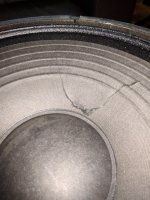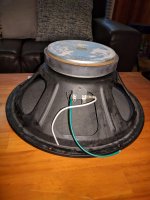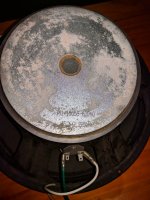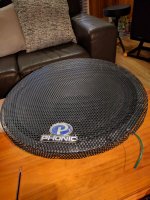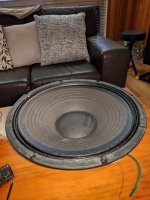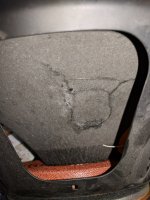Hi All.
Came across this 15" Phonic Woofer marked "341-15058-610-0 15" 6Ω 225W".
I'm not familiar with Phonic speakers, and don't know whether this driver is for PA, or hifi?
There's a tear on the paper diaphragm.
Is this repairable?
How would I go about re gluing it?
Is this driver worth repurposing?
If it can be successfully repaired, I was thinking of using it in a simple DIY Subwoofer build.
I would mostly use it in a 2.1 hifi system, or as part of a sound surround set up.
Alternatively, is there a market for the driver itself?
cheers
Cliff
Came across this 15" Phonic Woofer marked "341-15058-610-0 15" 6Ω 225W".
I'm not familiar with Phonic speakers, and don't know whether this driver is for PA, or hifi?
There's a tear on the paper diaphragm.
Is this repairable?
How would I go about re gluing it?
Is this driver worth repurposing?
If it can be successfully repaired, I was thinking of using it in a simple DIY Subwoofer build.
I would mostly use it in a 2.1 hifi system, or as part of a sound surround set up.
Alternatively, is there a market for the driver itself?
cheers
Cliff
Attachments
I use petroleum based contact adhesive very successfully. Timebond, Thixofix, EvoStik or Bostik in the UK. Draw a thin line of adhesive over the crack or tear and that will make a permanent repair.
Here is an idea of what I mean; Contact Adhesives RS Components
Here is an idea of what I mean; Contact Adhesives RS Components
I use petroleum based contact adhesive very successfully. Timebond, Thixofix, EvoStik or Bostik in the UK. Draw a thin line of adhesive over the crack or tear and that will make a permanent repair.
Here is an idea of what I mean; Contact Adhesives RS Components
Thanks Jon.
Would you also run adhesive over the crack/tear at the rear of the cone as well?
I think most of those brands are more likely to be available in the U.K.
Are you recommending traditional non water based contact cement?
The same as the glue used to affix veneers to timber or mdf?
Last edited:
I use woodworking PVA adhesive (and tissue paper if there is a gap to be filled). Apply to the tear front and rear.
Phonic makes PA loudspeakers.
Phonic makes PA loudspeakers.
Last edited:
Good video!
Cliff, just FYI - the ripped part is the speaker cone, not diaphragm. That will help you when searching or asking about it. Compression drivers for horns have diaphragms.
Cliff, just FYI - the ripped part is the speaker cone, not diaphragm. That will help you when searching or asking about it. Compression drivers for horns have diaphragms.
Careful application of a flexible abhesive sounds like the way to go, cones flex slightly in use and a glue that flexes with it will be less likely to start a new crease/tear.
Ultimately this is going to be the weak point, reconing is the ultimate fix - the cone vibration modes are going to change a bit with a repair, you want it to be close to the original cone. (But a torn cone is very obvious sound-wise as is leaks air noisily and allows the cone to flop about and anything is better than that! - even gaffer tape)
If you have the materials to experiment with gluing a tear in similar material before commiting to the real cone I'd try that - you might come up with a good technique and gain confidence - I'd be tempted to try adding a little extra paper just on the tear area (thin tissue paper perhaps) to bridge the gap with paper fibres, not just glue.
Ultimately this is going to be the weak point, reconing is the ultimate fix - the cone vibration modes are going to change a bit with a repair, you want it to be close to the original cone. (But a torn cone is very obvious sound-wise as is leaks air noisily and allows the cone to flop about and anything is better than that! - even gaffer tape)
If you have the materials to experiment with gluing a tear in similar material before commiting to the real cone I'd try that - you might come up with a good technique and gain confidence - I'd be tempted to try adding a little extra paper just on the tear area (thin tissue paper perhaps) to bridge the gap with paper fibres, not just glue.
You want *water* based adhesives, white carpenter´s PVA glue is best.
Cone is made out of a *water* based cellulose paste, stay there.
Draw a bead along slit, spread around slightly (sa1 1 or at most 2 mm each side of the cut, both front and back), what you want is to re-wet paper pulp so adhesion works on whole paper thickness, not just on surface.
Let rest 4 or 5 minutes and with a wet in glue small brush "comb" fibers towards slit, you areb trying not only to glue it but to partially reconstruct its structure.
Let dry for at least 24 hours and cone will be almost as good as new.
No solvent based adhesive will achieve that.
Cone is made out of a *water* based cellulose paste, stay there.
Draw a bead along slit, spread around slightly (sa1 1 or at most 2 mm each side of the cut, both front and back), what you want is to re-wet paper pulp so adhesion works on whole paper thickness, not just on surface.
Let rest 4 or 5 minutes and with a wet in glue small brush "comb" fibers towards slit, you areb trying not only to glue it but to partially reconstruct its structure.
Let dry for at least 24 hours and cone will be almost as good as new.
No solvent based adhesive will achieve that.
The only glue I’ve ever found that worked is the white stuff they sell specifically for reconing and installing foam surrounds and dust caps. Refoam kits always have some left over after a refoam, and I think PE sells it separately. It’s similar to Elmers white glue but stays flexible far longer and won’t simply dissolve in high humidity once dry. For larger tears I glue a piece of speaker paper on the backside for reinforcement. There’s always a sacrificial speaker around somewhere to steal from.
That's an interesting assertion - polysaccharides are based on saccharides which are poly-alcohols, so you could argue they are alcohol based with more justification. The polymerization bonds are ketones so they have some ketone character too. The important point is that the glue adheres to the thing, and many solvents can "wet" cellulose, both polar and non-polar, not just water.Cone is made out of a *water* based cellulose paste, stay there.
Phonic makes PA loudspeakers.
Although it's a PA loudspeaker, can it be used successfully in a hifi situation?
Don’t expect it to go down spectacularly deep. PA speakers aren’t going to go below 40 unless they are purpose-built to do so and this driver doesn’t fit that description to me. Most have trouble with 50 or 60 unless the cab is quite large. It will be louder with less power than most hi-fi subs, but maximum output in where you would expect a “subwoofer” to play would be even less than a typical 15” hi-fi sub. Looking at it I’d say x-max might be 6 to maybe 8 mm, and bottoming out at less than 15.
In comparison, would would the x-max be for 15" hifi speaker?
With that summary, would you say, "not worth the effort of building an enclosure around it".
With that summary, would you say, "not worth the effort of building an enclosure around it".
Last edited:
They would start at 8mm for the lowest of the low end, something reasonably priced would give 10-12. A driver with that large a motor would give you at least 15mm linear, well over 20 before bottoming out.
You won’t get that kind of bass out of it - it is simply designed for something else. It may be impressive compared to those toaster sized subs everyone is pushing because it would have a lot of bass at 60 Hz. But probably not a lot of earth moving rumble. Would make a nice bottom of a 3 way for a loud system playing classic rock.
You won’t get that kind of bass out of it - it is simply designed for something else. It may be impressive compared to those toaster sized subs everyone is pushing because it would have a lot of bass at 60 Hz. But probably not a lot of earth moving rumble. Would make a nice bottom of a 3 way for a loud system playing classic rock.
It may be impressive compared to those toaster sized subs everyone is pushing because it would have a lot of bass at 60 Hz. But probably not a lot of earth moving rumble. Would make a nice bottom of a 3 way for a loud system playing classic rock.
It's a pity I couldn't score 2 of them.
Atleast, visually, a 3 way with 15" woofers would look impressive.
- Home
- Design & Build
- Parts
- Repairing diaphragm on 15" Driver?
